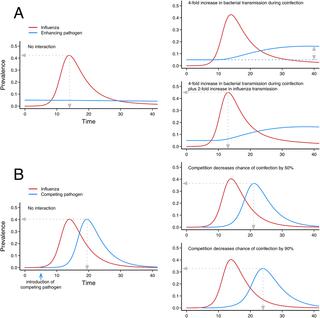当前位置:
X-MOL 学术
›
PLOS Pathog.
›
论文详情
Our official English website, www.x-mol.net, welcomes your feedback! (Note: you will need to create a separate account there.)
Influenza interaction with cocirculating pathogens and its impact on surveillance, pathogenesis, and epidemic profile: A key role for mathematical modelling.
PLoS Pathogens ( IF 6.7 ) Pub Date : 2018-02-15 , DOI: 10.1371/journal.ppat.1006770 Lulla Opatowski 1 , Marc Baguelin 2, 3 , Rosalind M Eggo 2
PLoS Pathogens ( IF 6.7 ) Pub Date : 2018-02-15 , DOI: 10.1371/journal.ppat.1006770 Lulla Opatowski 1 , Marc Baguelin 2, 3 , Rosalind M Eggo 2
Affiliation

|
Evidence is mounting that influenza virus interacts with other pathogens colonising or infecting the human respiratory tract. Taking into account interactions with other pathogens may be critical to determining the real influenza burden and the full impact of public health policies targeting influenza. This is particularly true for mathematical modelling studies, which have become critical in public health decision-making. Yet models usually focus on influenza virus acquisition and infection alone, thereby making broad oversimplifications of pathogen ecology. Herein, we report evidence of influenza virus interactions with bacteria and viruses and systematically review the modelling studies that have incorporated interactions. Despite the many studies examining possible associations between influenza and Streptococcus pneumoniae, Staphylococcus aureus, Haemophilus influenzae, Neisseria meningitidis, respiratory syncytial virus (RSV), human rhinoviruses, human parainfluenza viruses, etc., very few mathematical models have integrated other pathogens alongside influenza. The notable exception is the pneumococcus-influenza interaction, for which several recent modelling studies demonstrate the power of dynamic modelling as an approach to test biological hypotheses on interaction mechanisms and estimate the strength of those interactions. We explore how different interference mechanisms may lead to unexpected incidence trends and possible misinterpretation, and we illustrate the impact of interactions on public health surveillance using simple transmission models. We demonstrate that the development of multipathogen models is essential to assessing the true public health burden of influenza and that it is needed to help improve planning and evaluation of control measures. Finally, we identify the public health, surveillance, modelling, and biological challenges and propose avenues of research for the coming years.
中文翻译:

流感与共循环病原体的相互作用及其对监测、发病机制和流行病概况的影响:数学建模的关键作用。
越来越多的证据表明,流感病毒与定植或感染人类呼吸道的其他病原体相互作用。考虑与其他病原体的相互作用对于确定真正的流感负担和针对流感的公共卫生政策的全面影响可能至关重要。对于数学模型研究来说尤其如此,数学模型研究在公共卫生决策中变得至关重要。然而,模型通常只关注流感病毒的获得和感染,从而使病原体生态学过于简单化。在此,我们报告了流感病毒与细菌和病毒相互作用的证据,并系统地回顾了纳入相互作用的建模研究。尽管有许多研究探讨了流感与肺炎链球菌、金黄色葡萄球菌、流感嗜血杆菌、脑膜炎奈瑟菌、呼吸道合胞病毒(RSV)、人类鼻病毒、人类副流感病毒等之间可能存在的关联,但很少有数学模型将其他病原体与流感一起整合。值得注意的例外是肺炎球菌与流感的相互作用,最近的几项建模研究证明了动态建模作为测试相互作用机制的生物学假设并估计这些相互作用的强度的方法的力量。我们探讨了不同的干扰机制如何导致意外的发病趋势和可能的误解,并使用简单的传播模型说明了相互作用对公共卫生监测的影响。我们证明,多病原体模型的开发对于评估流感的真正公共卫生负担至关重要,并且需要它来帮助改进控制措施的规划和评估。最后,我们确定了公共卫生、监测、建模和生物学挑战,并提出了未来几年的研究途径。
更新日期:2018-02-16
中文翻译:

流感与共循环病原体的相互作用及其对监测、发病机制和流行病概况的影响:数学建模的关键作用。
越来越多的证据表明,流感病毒与定植或感染人类呼吸道的其他病原体相互作用。考虑与其他病原体的相互作用对于确定真正的流感负担和针对流感的公共卫生政策的全面影响可能至关重要。对于数学模型研究来说尤其如此,数学模型研究在公共卫生决策中变得至关重要。然而,模型通常只关注流感病毒的获得和感染,从而使病原体生态学过于简单化。在此,我们报告了流感病毒与细菌和病毒相互作用的证据,并系统地回顾了纳入相互作用的建模研究。尽管有许多研究探讨了流感与肺炎链球菌、金黄色葡萄球菌、流感嗜血杆菌、脑膜炎奈瑟菌、呼吸道合胞病毒(RSV)、人类鼻病毒、人类副流感病毒等之间可能存在的关联,但很少有数学模型将其他病原体与流感一起整合。值得注意的例外是肺炎球菌与流感的相互作用,最近的几项建模研究证明了动态建模作为测试相互作用机制的生物学假设并估计这些相互作用的强度的方法的力量。我们探讨了不同的干扰机制如何导致意外的发病趋势和可能的误解,并使用简单的传播模型说明了相互作用对公共卫生监测的影响。我们证明,多病原体模型的开发对于评估流感的真正公共卫生负担至关重要,并且需要它来帮助改进控制措施的规划和评估。最后,我们确定了公共卫生、监测、建模和生物学挑战,并提出了未来几年的研究途径。


























 京公网安备 11010802027423号
京公网安备 11010802027423号